
1 .
This vinyl record is the first edition of Dire Straits’ debut album, numbered 6360 162, released in 1978.
That year, China reinstated the national college entrance exam and began its reform and opening-up policy. Future Asian superstars Sun Yanzi and Ayumi Hamasaki were born in that year. The 37-year-old Bob Dylan embarked on a global tour, making his first appearance at the Nippon Budokan in Japan and preparing for the biggest stylistic change of his career after his legendary status was established.
Meanwhile, four young men from London, who had been performing in underground venues for several years, pieced together their first album. They shot to stardom right away, and the album later sold more than 11 million copies worldwide, becoming a double platinum record in the UK and the US. It also catapulted the precocious Mark Knopfler into the ranks of the greats.
The condition of this vinyl record is very good, with the disc in basically new condition. The only marks are the faint ballpoint pen strokes under the title on the cover that read "M. Knopfler," though it’s unclear who wrote this or when.

The back cover features a photo of the four band members, with lead vocalist and guitarist Mark Knopfler, who was only 29 at the time, but already as skilled on his guitar as his receding hairline suggested. His raspy voice has hardly changed in the more than 40 years since. Before pursuing music full-time, Mark was an English teacher, known as "Teacher Ma."
Next to him are rhythm guitarist David (Mark’s younger brother), bassist John, and drummer Pick. The photo looks like a sly old father with his three innocent sons, and it may well have been like that in reality.
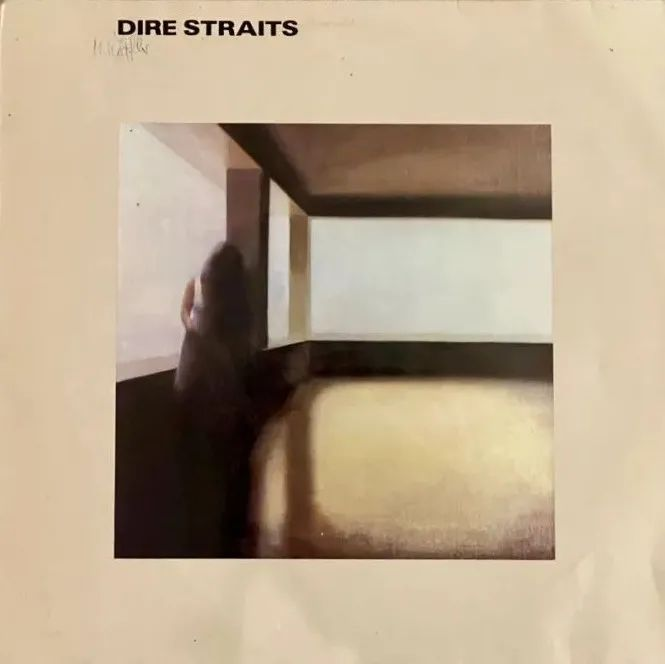
The album cover is an unclear painting of a woman leaning against a wide window, with what appears to be a foggy river outside. The style of the painting is very similar to the AI-generated art that is popular today. The cover was designed by a studio called Hothouse at the time, and the artist who painted it was named Chuck Loyola, about whom little information is available.
It is unknown how the cover was created, but some have speculated that it was inspired by Wood Wharf Studios, where Dire Straits often rehearsed and recorded. The painting may have been created with the intention of reflecting the meaning of the album’s first song, "Down to the Waterline."
Wood Wharf Studios, located by the Thames River, has hosted British musicians such as Dire Straits and Kate Bush. It is said that Don from the Eagles also rehearsed there and even dodged a bill.
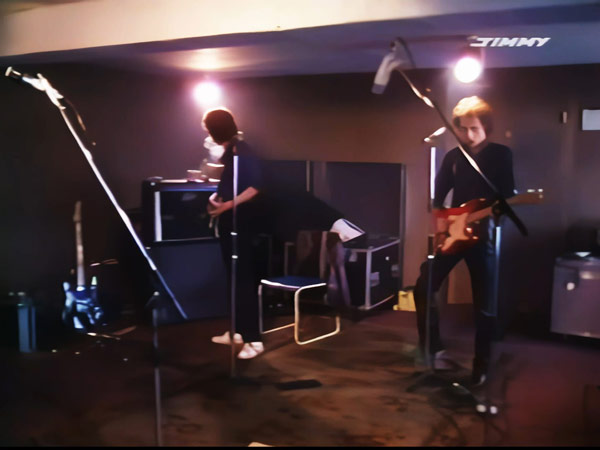
Dire Straits at the Wood Wharf Studios
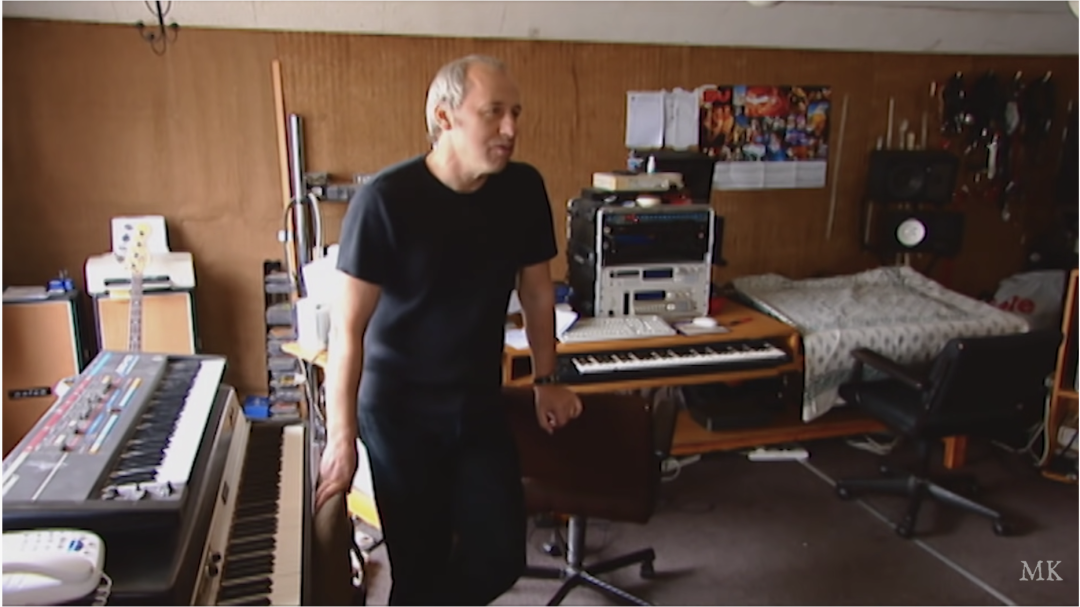
More than twenty years later, in the documentary of Mark’s solo album "Sailing to Philadelphia" (also one of my favorite albums), he returned to Wood Wharf and reminisced about the scene. The studio, located near Greenwich in London, faces the Thames River, and surprisingly can still be found on Google Maps, although it may no longer be a recording studio. In a street view photo, a young man wearing headphones is standing in front of the building, and I wonder if he is listening to "Down to the Waterline."

2 .
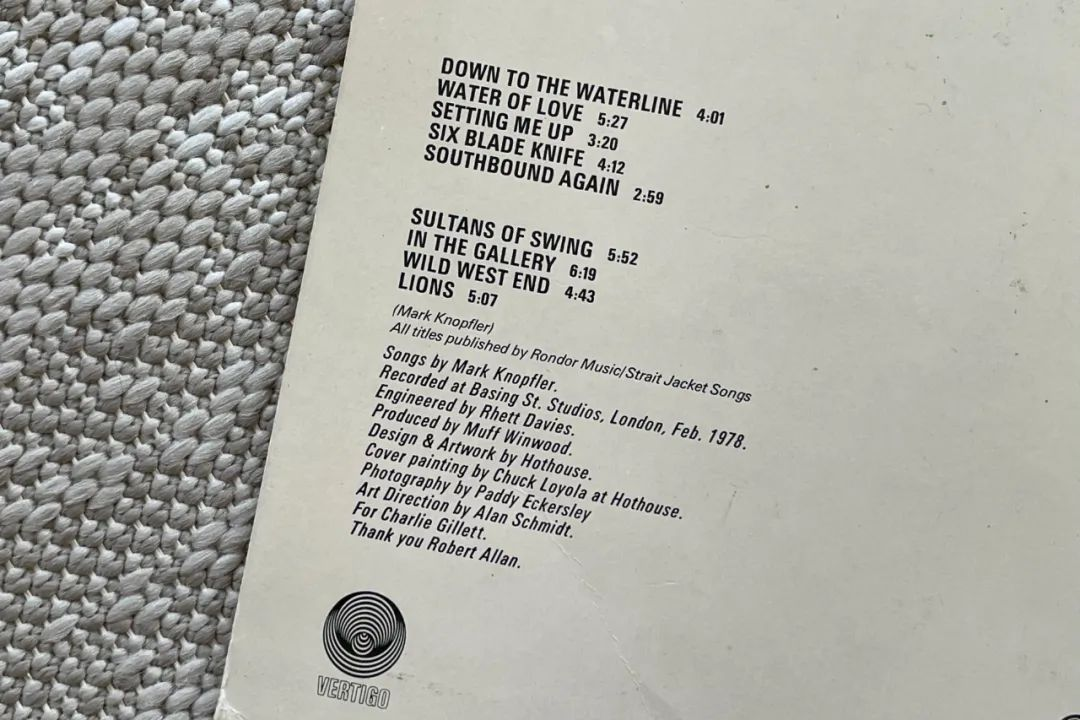
This album contains nine songs, all written by Mark.
The narrative and rhythm of the entire album were clearly carefully planned, with a subdued start, gradually building up to the climax of "Saltans Of Swing" on the B-side, and then incorporating even more dynamic musical elements in the following three songs. Some say that if you had to describe Mark’s music in one word, it would be "elegant", a quality that shines through on this album.
Mark’s songs are like stories, telling vivid and evocative tales that are not always clear, but always rich in imagery. This album is no exception and shares many echoes with Mark’s later work.
Mark’s love songs are restrained yet tender. When listening to him sing on "Wild West End":
Excuse me for talking I wanna marry you
This is the seventh heaven street to me
Don’t you seem so proud
You’re just another angel
In the crowd and I’m…
Walking in the wild west end
Walking in the wild west end
Walking with your wild best friend
One might be reminded of "Invisible Wings" by the rock band Black Panther, with its whispered verses and roaring chorus, telling the same story:
In the crowd and the chaos I see your face,
Just as charming and beautiful as ever.
Slowly relax and gradually let go,
But it’s still the same, we don’t care.
There’s no need to say too much, we know,
What we really want to do.
Don’t care too much, and don’t be too sad.
…
I always like to start listening from the B-side, because "Saltans Of Swing" is simply perfect – the stunning guitar work, the smooth rhythm, the tight collaboration – the moment the music flows out of the record player, it will capture your whole body and make you forget everything else.
This was also the band’s first song that helped them get their break. At the time, they scraped together £250 to record a demo, which they sent to London radio host Charlie Gillett. From then on, they were discovered and finally had the opportunity to produce their debut album.
Mark has expressed his gratitude to Charlie on many occasions. You can also see "For Charlie Gillett" in the text on the back of the album cover, paying tribute to the talent spotter.
The album was released by Vertigo, a label under Phonogram at the time, with the catalog number LC1633. Vertigo’s logo was also one of the most popular record labels. The album was recorded at Basing st. Studios in London, which was much more professional and had recorded countless British classic records.
The album was produced by Muff Winwood, the older brother of the more famous Steve Winwood. They had played together in The Spencer Davis Group. Later, Muff became a professional producer and helped many British musicians and bands produce records. Perhaps his life was much more ordinary than his younger brother’s, but every professional in the vast music industry behind the scenes, who helps create such finely crafted music, deserves respect.
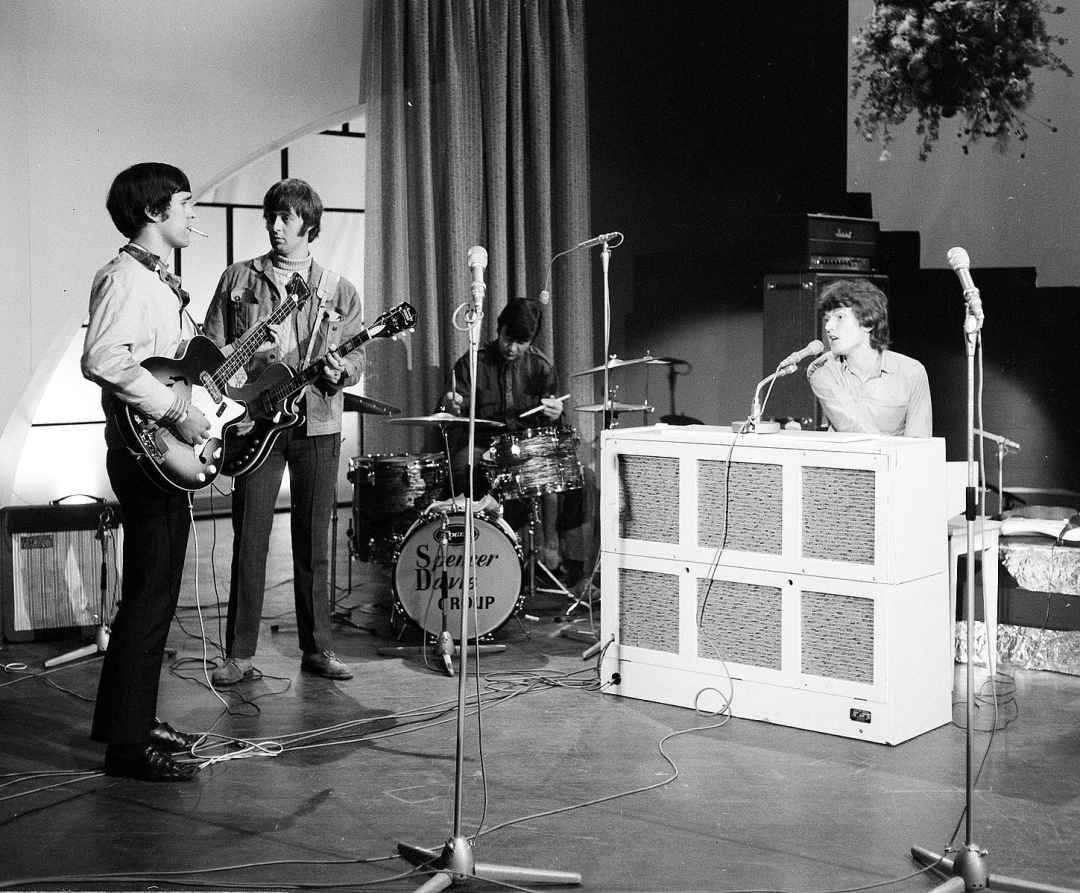
The Spencer Davis Group in 1966, from left to right are Muff Winwood, Spencer Davis, Pete York, Steve Winwood.
3 .

On the back bottom of the album cover, there is a Fender guitar mark with the words "Dire Straits" and some versions have this mark in red.
This may represent the guitar that Mark loved the most at the time, the Fender Stratocaster. He bought two Strats back then, a second-hand 1961 and a (possibly replica) 1962. These guitars were used in this album, including the previous demos and live performances at the time.
Mark had a deep love for guitars since he was a child. It was not until he was 15 years old that his father bought him a red Hofner guitar for 50 pounds, which opened the way for him to play the guitar. He said that he couldn’t afford effects pedals at the time, so he dismantled the radio and experimented with it, and discovered more playing techniques.
When he could afford a real second-hand Fender, he also repainted the damaged finish in the same red color. Later, Mark owned a Fender Stratocaster named after himself, and the 1961 was hung in his home as a collection item.

Picture of Mark Knopfler and his beloved red Fender Stratocaster.
4 .
"Dire Straits" is translated as "恐怖海峡" in China, but its original meaning in English is "a difficult situation" or "a dead end." This underground band, which had been struggling for two or three years before being discovered, jokingly changed their name to Dire Straits. But soon, like a giant ship that has sailed through treacherous waters, they entered the vast ocean of freedom.
Their debut album was well received, and they soon began touring and promoting in Europe, paving the way for the band’s stardom, or rather Mark’s stardom.
At that time, Talking Heads from the other side of the Atlantic had successfully released their debut album "Talking Heads: 77" a year earlier. When they came to the UK for promotion in 1977, the relatively unknown Dire Straits was the opening band. Soon, a year later, Dire Straits went on a tour of North America, and Talking Heads also came over as a guest. These two bands were so alike, both having a young and talented soul who was about to fly solo.
It was probably during that trip to the United States that Mark met Bob Dylan and participated in the recording of "Slow Train Coming." The two admired each other, but their relationship remained distant and aloof until they toured together more than thirty years later.
At that time, Eric Clapton, four years older than Mark but already famous, was in another period of adjustment in his own chaotic life. Years later, the multiple performances of the two masters on the same stage became timeless classics.
I carefully took out this 44-year-old record from its layers of covers at home, wiped it clean, and played it on my record player. Listening to the four young men’s leisurely performance, I seemed to smell the air of 1978.

Picture of the band on the back of the lyrics page of the record, by Paddy Eckersley.
References:
- https://www.discogs.com/release/2896055-Dire-Straits-Dire-Straits
- https://www.direstraits.com/about/
- https://en-academic.com/dic.nsf/enwiki/9825601
- http://universodirestraits.blogspot.com/2021/06/was-it-revelation-of-inspiration-for.html
- https://www.wattpad.com/824315800-on-the-waterfront-wood-wharf
- https://www.youtube.com/watch?v=nwOzONsGGLo
- https://www.theguardian.com/music/2011/oct/11/mark-knopfler-bob-dylan-manchester-review
- https://www.groundguitar.com/mark-knopfler-gear/
- https://www.classicrockreview.com/2018/11/1978-dire-straits/
- https://www.udiscovermusic.com/stories/dire-straits-dire-straits-album-2/